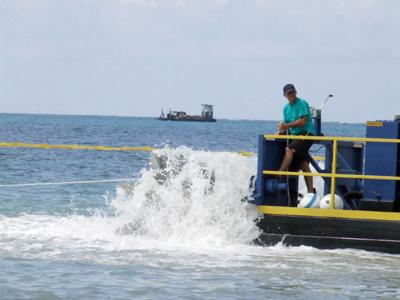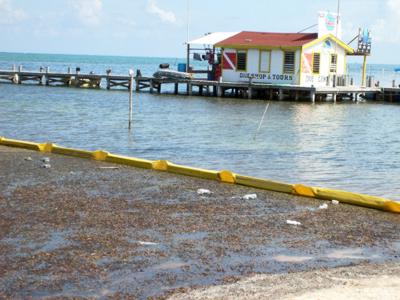October is Designated “Clean Up San Pedro” Month
 |
Although on occasion local citizens organize and participate
in clean-up days the community as a whole needs to make an effort to
maintain cleanliness at all times. Litter is not only unsightly but is
a health hazard to people and the environment.
|
 |
It is not just the beaches that are littered with garbage but
the entire island, and it is up to the residents to do something about
keeping La Isla Bonita clean.
|
A committee of town council and community members has been formed to spearhead a clean-up campaign on “La Isla Bonita.” Their first public meeting was held on Friday, July 27th at Fido’s Courtyard where key community members were invited to partake in planning and implementing the campaign. Committee members, Mayor Elsa Paz, Councilor Nano Guerrero, Mayor’s Assistant Felix Ayuso and Tammy Peterson lead the meeting and introduced the concept behind making San Pedro “the cleanest island in the Caribbean” campaign.
Tammy Peterson, who initiated the campaign, addressed the group by outlining the motives behind the campaign, pointing out that not only is San Pedro a tourist destination that needs to be clean and attractive at all times, but that as a community we should care about our “home” and strive to keep it clean. Mayor Paz added that the Town Council, with Councilor Guerrero at the lead, has been very focused on keeping the island clean and has worked hard to provide consistent garbage collection services, distribute garbage receptacles throughout the community and maintain public street cleanliness. Although these services are in place the problem of litter and un-proper garbage disposal remains to be a problem. Felix Ayuso mentioned that the Town Council has promoted a “La Isla Bonita es mi casa; and I like mi casa clean!” clean-up campaign in the past but now is the time to “step up” the efforts and really engage the community.
The Mayor has deemed October “Clean Up San Pedro” month and the committee is working on fun and exciting ways to involve the community. In an attempt to inspire the community the committee is currently identifying a public area that will be used to demonstrate the “before and after” effects of a clean-up effort. During the month of September the area will be cleaned and the community will have the opportunity to see the benefits that result from removing garbage from a littered area and appreciate the appeal of a clean and well kept property afterwards.
The official campaign is slated to kick-off Saturday, September 29th with a festive beach party at Central Park, complete with music, food, beverages, guest speakers and even a garbage sculpture contest for the kids. Awards and prizes will be presented along with introductions to other community clean-up competitions to be held through out the month. During October, residents, business owners and property owners are asked to clean up their yards and neighborhoods. Plans are underway for additional garbage collection on Sunday’s during the month and the Town Council will be offering assistance to those who are physically unable to clean their property.
The campaign is scheduled to end on November 3rd, and after that time members of the clean-up campaign will be authorized to issue tickets to those who litter. In a press release issued in January 2007, the San Pedro Town Council advised the general public that commencing February 12th, 2007 Littering Offences Violation Tickets would be given to those who commit a littering offence and that littering is against the law. It is the full intent of the Town Council to stringently enforce this law after the clean-up campaign is completed.
Other efforts to educate the public about the hazards of littering will be through a series of commercials to be produced by the Town Council. Peace Corp volunteer, Alli Morris, has offered to assist with message creation and creative design of the commercials that will appeal to many different age groups.
For more information about this campaign please contact Tammy Peterson at [email protected] or call 620-0009 or contact Felix Ayuso at [email protected] or call 621-9843.
The impact of dredging on our environment
 |
A lot of people don't know how negatively dredging impacts
our fragile environment.
|
 |
As can be seen, dredging also destroys seagrass beds, which
are prime breeding grounds for many types of marine life, the
repercussions of which are extreme.
|
Dredging is the term given to digging, gathering, or pulling out material to deepen waterways and keep waterway entrances and approaches to boat ramps clear. The material removed during dredging can vary greatly and can be any combination of rocks, clays, silts or sands.
It does seem like a necessity especially one required when living on an island. Transportation by boat is a way of life and bigger boats are needed as the years go by. However, one must understand that if you plan to dredge you must gain consent from the Department of Geology and Mines under the Ministry of Environment to use and develop coastal Crown land. Applications should be made on a specific application form for dredging and follow the guidelines, rules and regulations pertaining to that particular practice.
However, one must also understand the impacts that dredging has on our environment. Of course, the waters surrounding your dock or marina will be deeper, and yes, you will have material that is removed from the sea bed which may be used as fill, however, the impact created are far bigger than that.
Dredging activities have the potential to change the environment. One must take into consideration that the second largest barrier reef system in the Western Hemisphere lies only about half a mile on the windward side of Ambergris Caye. Anything occurring within the proximity of this will affect it either positively or negatively and dredging may just have a negative effect.
Marine environment/communities – At the sites of dredging and disposal the seabed and associated communities are disturbed and for some distance, suspended sediment may cause turbidity in water and increased sedimentation on the bottom.
Water quality – Depending upon the nature of the dredged material, its disturbance from the sea bed may lead to changes in the chemical composition of the water. For example, many toxicants such as heavy metals and organic contaminants tend to stick to particulate matter and sink to the sediment. Some of these contaminants are very persistent in the sediment and some may change their oxidation state during burial, which alters their solubility. If these sediments are disturbed, the contaminants can be released to the water column and affect marine life.
Human health – As well as toxicants, the nutrient elements, particularly nitrogen and phosphorus, which control the rate of marine plant growth can also be released from sediments during dredging, with a risk of triggering algal blooms. Not only nutrients are important here - many of the toxic algal species, which are a health risk for consumers of shellfish, have a resting stage (cyst) which lies in the sediment. If dredging disturbs these cysts when conditions are favorable, a bloom of toxic algae may be caused.
Entrainment – Entrainment occurs when organisms are trapped during the uptake of sediments and water by dredging machinery. Benthic infauna are particularly vulnerable to being entrained by dredging uptake, but mobile epibenthic and demersal organisms such as burrowing shrimp, crabs, and fish may also be susceptible to entrainment under some conditions.
Noise – It has been documented that underwater noise can influence fish behavior. This is likely linked to the importance of sound to fish when they hunt for prey, avoid predators, and engage in social interaction.
One thing that must remain in our minds is that no real study has been done in Belize. No study pertaining to the effects of dredging has been ever carried out. Why? With the Belizean Barrier Reef at approximately 250 kilometers in length there is only 11% of live coral coverage. In order to preserve this percentage and help the reef survive bigger steps need to be taken. Are you playing your part?

|





